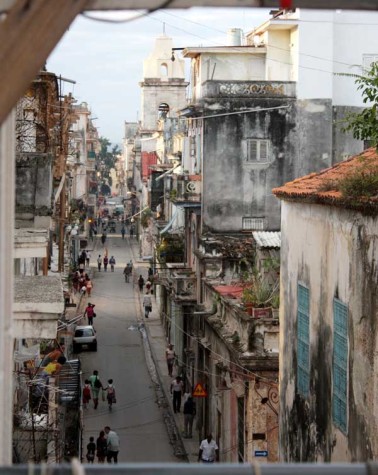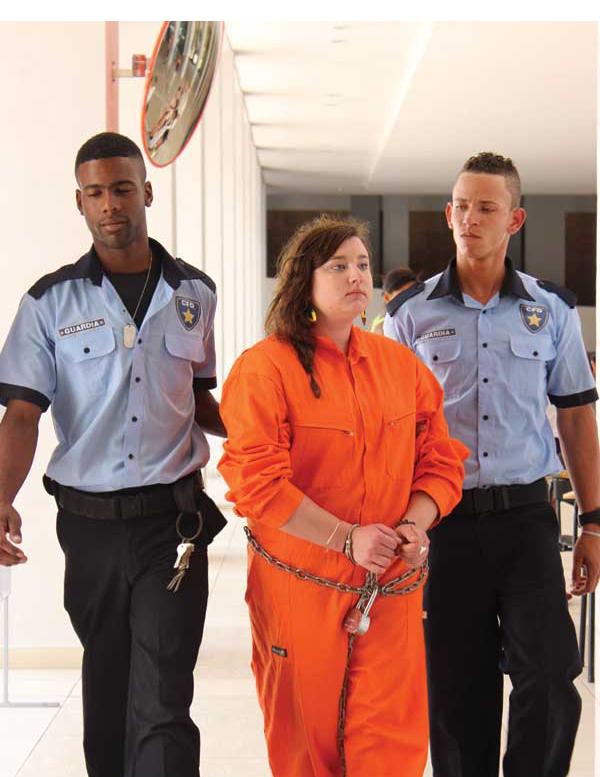Cuba: Not everything makes sense, but it is absolutely beautiful
Lindsay Brown immersed in an art installation at the Havana Museum of Fine Arts
“There is no congruency to Cuba: before, during, or after,” wrote Johnson State College student and fellow traveler Jeff Capen. “What you think you know is not what is, and not everything makes sense – but it is absolutely beautiful.”
JSC students enrolled in the class Art and Culture of Cuba, including myself, left the dour Vermont weather for an island of sunny skies, high temperatures, and green flora. For nearly 52 years the United States has had a financial embargo against this 42,803-square-mile paradise, taunting would-be tourists from both countries which lay a mere 90 miles apart from Florida’s southern tip. This means no trade, no tourism, and no fun between our two countries. Nada.
Obviously, this has adversely affected millions of people and come under the condemnation of the United Nations for the past 22 years. In 2013 the General Assembly vote was 188-2 for the end of the embargo, with only the United States and our faithful companion, Israel, digging their heels in the ground.
So when JSC students went on a trip from April 5-12, we were using a relatively new license granted under the Obama administration permitting accredited schools and universities under a general license for educational purposes to travel to a country few U.S. citizens are familiar with. Certainly in our generation, only a rare handful has ever seen its turquoise waters and white beaches; therefore I can say with a degree of certainty JSC has given me an experience both memorable and scholastically unique.
In preparation for the trip all students were required to become familiar with the forbidden country. Students were required to watch four Cuban movies and read the “Cuba Reader,” a 700-page compilation of stories representing a broad spectrum of viewpoints. From that they had to choose ten passages that interested them and write about it.
Associate Professor of Writing and Literature Tyrone Shaw, a sincere opponent to the embargo who has also written a commentary on it to the VTDigger titled “Tear down this wall,” explained how sees Cuba as a nation on the brink of self-discovery.
“From a sociological and political perspective,” he said, “Cuba is at a particularly interesting point of transition, approaching the end of more than 50 years of a communist/socialist system dominated by the Castros and poised to enter the post-Castro era, which is a huge question mark. Can Cuba retain its frayed but remarkably durable social safety net, including an infant mortality rate lower than ours, a literacy rate that is higher, and equivalent life expectancy while moving into more of a free market society?”
Because of the heavy political atmosphere, students visited the Bay of Pigs and learned the Cuban perspective on the history, as well the mixed views of Castro’s revolution.
However, as an arts and culture trip, Shaw also wanted to show students the island’s “vibrant” art scene replete with “painting, music, ceramics, lithography, writing, and cinema.”

While the itinerary was flexible and not every place was visited (they had hoped to catch a baseball game) some places, like the Museum of the Revolution, the National Museum of Fine Arts, and Callejón de Hamel. On that street, Cuban-African murals and poems pondering the journey of self-discovery or love coated the once crumbling walls as part of a neighborhood transformation driven by artist Salvador Gonzáles Escalona. Interestingly, he has JSC connections, having been there in 1996 as a visiting artist.
It was at the National Museum of Fine Arts, however, that we found an interactive demonstration of the perceived injustice of the Cuban Five, the five nationals who have been imprisoned by the United States government on charges of conspiracy to commit espionage. In this exhibit people were dressed in an orange jumpsuit and treated as though being arrested – shoved against a wall, screamed at, and put in an isolation chamber for five minutes.
A few students chose to do this – hence the front page photo.
One captivating art exhibit was Fusterland, which I can only describe as an art playground composed of mosaics squashed between suburban bungalows. When the travel between Cuba and the U.S. is lifted, as people on both sides of the ocean are anticipating, there is little doubt this glittery architecture of art will be a large draw.
How this will alter the face of Cuba is unknown; currently much of the country is in need of drastic repair; gaping holes in the streets are waiting to be filled and neglected rooftops are sprouting tiny forests. And if the financial regulations disappear, so might also the huge population of 1950s-era cars that fascinate a nostalgic-infused American public as Cubans trade in their Frankenstein machines that seem to be held up only by Bondo and prayers for newer vehicles.
To cater to the anticipated tourism, buildings, and one could argue the culture, will likely be painted over to hide the rustic authenticity of a struggling country.
Of course, this place that seems time-stamped in a curious cross between European architecture, Caribbean countryside, and 1950’s American car industry holds some quirks that take some getting used to.
For example, toilet paper is thrown away in trash cans, not down the pipes ill-equipped to handle the bulk. All shapes and sizes of women are admired – a refreshing change from the limited scope of accepted beauty by American standards.
Light-skinned visitors are frequently the targets with sought after hard-currency by those who are disposed to begging – a tourist if often asked for a peso, her clothes, to buy milk for a baby, charged for taking a photo, or sometimes, as I once was, charged for watching them crush cans.
By the time that happened, I was feeling like a veteran tourist, and was able to say no with only a little bit of guilt.
“We should remember that it is also a third world country,” shared Liz Conrad, a student who went on the trip. “The city itself has a colorful personality that is made up of intricate architecture, convivial people, and a warm climate; however, it is also impoverished, and living conditions for many people are sub-par. I felt that it was a good reminder that all destinations have two faces– the one that the tourists see, and the one that the people see. Our group was fortunate to be able to learn about Cuba through the eyes of the locals, and I think it really enhanced our understanding of the culture there.”
Although there are resorts catering to first-world tourists, Shaw and Professor of Fine & Performing Arts Ken Leslie chose to have the group stay in casas particulars in Old Havana– the equivalency of U.S. bed and breakfasts.
Although housed right next to the ghettos of Havana, both professors said it was safe for students and encouraged them to explore on their own, meet the people, and formulate their own opinions on the tropical paradox that is Cuba.
Leslie viewed the trip as way for students to learn life-skills. He said for some people travelling can be a frightening and mysterious thing, and fear of the unknown can make them feel restricted to if and how they can travel.
“We open that door for them to experience it in a small or big way on their own,” he said. “It isn’t as if we’re trying to give anybody their one, single, life experience of …traveling. We’re trying to open a door of possibility… We’re trying to put people through an experience of exploring something in a way that they not only learn that thing, but learn how to do future explorations on their own afterward.”
Certainly Capen, who spent much of his time interacting and networking with the locals and said he fell in love with the place, got that lesson. Accepting the quirks of the culture whole-heartedly, he dived into it head first.
“I threw myself at Cuba and I was received with grace by the people, sounds, and sights,” he wrote. “If you ever get the chance to visit Cuba, don’t ask how – just say when! Viva Cuba!
Students who went on the Cuba trip will be presenting their projects about it May 7.
Kayla served as a general assignment reporter and photographer for the spring 2013 semester. She returned for the Fall 2013 and spring 2014 semesters...



